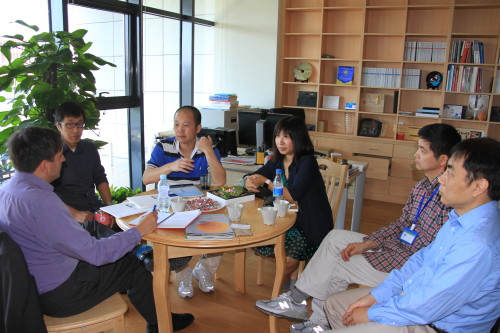
Calculated efforts: Matin Durrani (far left) in conversation with staff at the Beijing Computational Science Research Center, including Hai-Qing Lin (third left). (Courtesy: Mingfang Lu)
By Matin Durrani in Beijing, China
The last couple of days in the Chinese capital have been unusually damp and cool for the middle of June. Today, however, dawned sparklingly sunny as I headed off with my colleague Mingfang Lu from the Beijing office of the Institute of Physics, which publishes Physics World, to the Beijing Computational Science Research Center (CSRC) on the outskirts of the city.
Located on a shiny new software park, this sleek, five-storey building opened in March last year and looks just how you might expect the headquarters of IKEA to be – all minimalist corridors, big glass windows and the odd work of art dotted around. There’s even a fitness room in the basement. It’s currently got 43 full-time faculty, a third of whom are physicists, making this 45,000 m2 building – roughly the size of seven football pitches – seem remarkably sparse.
But as the centre’s director – the condensed-matter physicist Hai-Qing Lin – explained to me over coffee, each faculty member will be expected to recruit a group of about 10 people. So it should fill up fairly fast. In fact, the centre already has about 160 graduate students and postdocs, as well as 40 or so associate members. Where they were, though, as I toured this cavernous building, I’m not quite clear, but things should get more crowded when a graduate school opens next year.
The centre’s work is highly multidisciplinary, focusing in particular on condensed-matter physics, biological and soft matter, data analysis, chemistry, mechanics and quantum physics. Down in the vaults of the building is what the centre is all about: a massive, black 800 teraflop supercomputer that researchers use to do their calculations.
Built by the National University of Defense Technology, the machine is so complex that it uses “a significant part” of the the CSRC’s annual budget to keep it cool, according to Lei-Han Tang, head of the centre’s complex-system division, as he showed me round. In fact, the machine is so in demand that all time on it is fully booked until the end of this year. Fortunately for the director, 12% of the computer’s time is discretionary so I guess he gets to use some of it himself.
One thing that surprised me is that the centre doesn’t have any collaborations with local firms on the software park. They include DiDi, the Chinese version of taxi-firm Uber, in which Apple has just invested $1bn. While the centre’s focus is on cutting-edge basic research, it surely can only be a matter of time before one of its many staff or students comes up with a clever idea that someone in China will make a lot of money from.
Did you find out as to where is installed the Chinese fastest computer in the world and its significant parameters?
Is there any computing application on the horizon that does not concentrate even more wealth in the even fewer hands of IT billionaires?